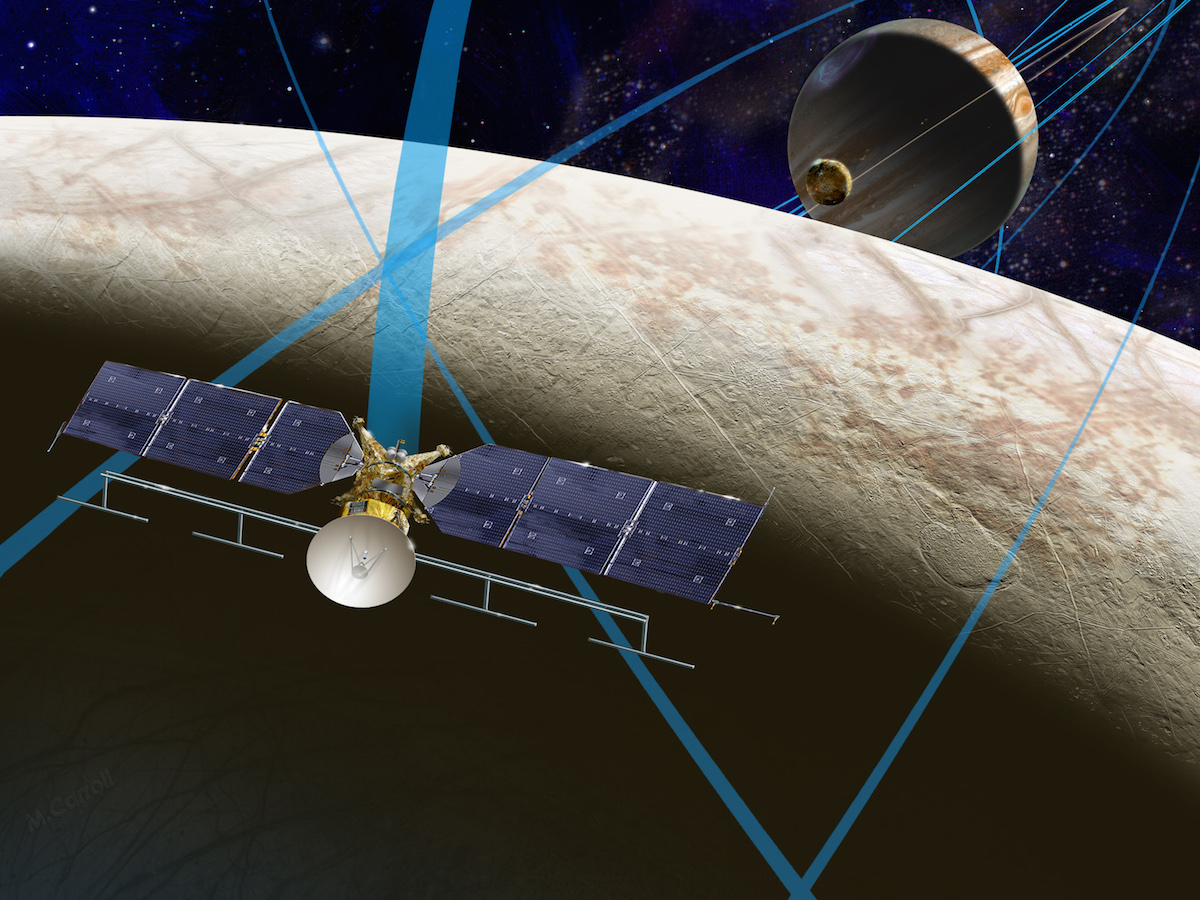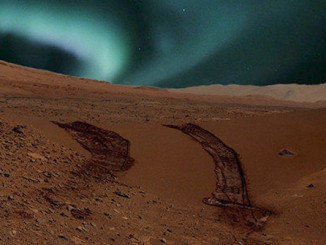After walking away from a previously planned joint mission to Jupiter, NASA has asked the European Space Agency if it can furnish a lander or ice-penetrating probe for a rejuvenated U.S.-led robotic spacecraft to visit Jupiter’s moon Europa.
NASA’s mission to Europa is scheduled to launch in the mid-2020s to begin a multi-year journey to Jupiter. Once it arrives, the probe will loop into an ever-changing orbit carrying it past Europa dozens of times.
Engineers and scientists at NASA’s Jet Propulsion Laboratory have worked on a design that will likely form the foundation of the mission. Called Europa Clipper, the mission would conduct 45 flybys of Europa in the late 2020s and early 2030s.
The Europa mission has fresh life after winning support from the White House earlier this year, and NASA plans to formally begin development of the spacecraft as soon as mid-2015. The milestone will put the mission beyond a gate no other Europa probe concept has ever passed, despite multiple iterations of concepts and plans left on the shelf after redesigns and funding woes.
NASA settled on a Europe flyby mission after deeming an orbiter or heavily-instrumented lander too expensive for the U.S. budget, but officials have not given up deploying a barebones probe to Europa’s surface.
One outcome of NASA’s engagement with ESA could be a mission similar to Cassini-Huygens, which included a U.S.-built Saturn orbiter and a European lander that descended to the gas giant’s methane-shrouded moon Titan.
“We’re trying to recreate some of the excitement we had at Saturn and Titan with one of our most valued partners,” said Jim Green, manager of NASA’s planetary science division.
In an interview at the Lunar and Planetary Science Conference in March, Green said NASA requested ESA examine whether it has the interest and the funding to contribute something to the Europa mission.
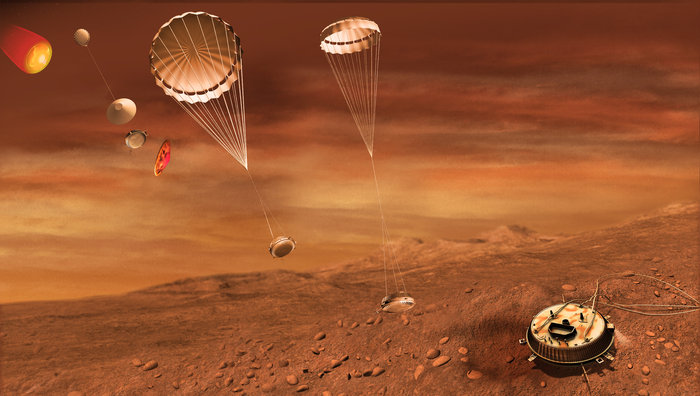
“It could be a lander, it could be a penetrator, or it could be a probe to fly through the plumes,” Green said, referring to supposed detections of watery eruptions from Europa’s icy crust. “These are the things we have asked ESA to look at.”
Europa is encased in a thick global ice shelf floating on an underground ocean of liquid water, and Jupiter’s fourth-largest moon is a prime location for scientists looking for extraterrestrial life in the solar system. Researchers say they have found evidence for scattered lakes just below Europa’s frozen crust, and closer to life-supporting nutrients.
A dedicated mission to Europa could survey the ice sheet, map its fractures and locate vents that expose the underground salt water reservoir to space.
Any addition to NASA’s Europa mission’s will make the spacecraft heavier, but engineers have not finalized the craft’s official design, so officials said it is too soon to know how a piggyback probe could impact the mission’s launcher and trajectory to Jupiter.
The Europa Clipper concept’s development schedule could have the mission ready for launch by June 2022, said Barry Goldstein, the Europa Clipper pre-project manager at JPL. Engineers have examined launching the mission on NASA’s new heavy-lift Space Launch System or on the most powerful version of the Atlas 5 rocket.
Fabio Favata, head of ESA’s science planning and community coordination office, said an internal assessment is underway to determine if a Europa piggyback probe is feasible within the agency’s medium-class mission line. The last medium-class mission approved by ESA, the exoplanet-hunting Plato telescope, had a cost cap of 600 million euros, or about $635 million.
“What we have done is to have a very simple look at what kind of possible collaboration scenarios could one realistically implement, supposing we were to take a medium mission funding slot,” Favata said in an 8 April interview. “Could we do something? What would be the possible technical mission profiles?”
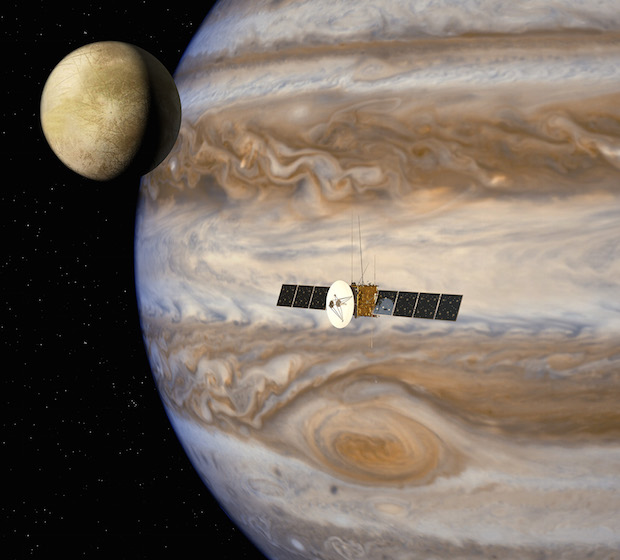
ESA divides its robotic science missions into small, medium and large segments. Favata said the agency should pick finalists for its next medium-class science project – the M4 mission – in June after analyzing proposals submitted by research teams across Europe.
Once ESA managers decide which proposal will go forward – and how much it will cost – officials can plan when to start the next medium-class mission competition. If ESA concludes it is interested in partnering with NASA on the Europa mission, scientists could present concepts in the selection round for Europe’s M5 mission, according to Favata.
“What will we do is to make the result of this internal study available publicly, and then if and when there is a suitable call for missions, if some members of the community are interested in having a look at this and using it as a basis for a proposal, it gives them a realistic starting point,” Favata said. “Nothing would prevent anybody from saying, ‘We would still like to go to Europa with NASA, but we don’t like what you guys have been talking about, or we don’t believe this is the right mission scenario,’ and propose something completely different. This would be evaluated without prejudice.”
Favata stressed it will be up to European scientists to decide whether a Europa probe is worth proposing, but he said any contribution will likely be in the form of a structural component – like a secondary spacecraft – rather than scientific instruments.
“ESA doesn’t decide on missions in smoke-filled rooms,” Favata said. “As for any ESA mission, it is something which comes from an open call for missions or an open call for proposals. Assuming scientists find it interesting, they will respond.”
The current trans-Atlantic discussions on the Europa mission come four years after NASA opted to prioritize a new Mars rover over a joint U.S.-European project that would have dispatched two spacecraft to Jupiter in 2020.
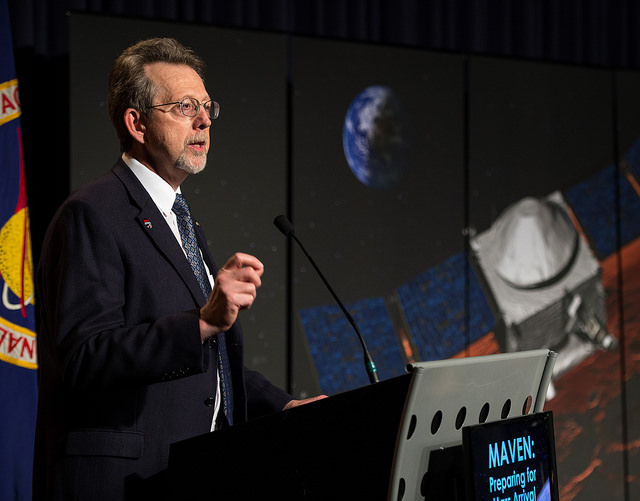
NASA followed the recommendations of a “decadal survey” by the National Research Council, which urged the space agency to begin work on a series of missions to return soil samples from Mars to Earth. The new Mars lander is based on the design of the Curiosity rover now on the red planet, and it is scheduled for launch in 2020 with a suite of science experiments and equipment to collect and store samples for retrieval by a later mission.
The U.S. withdrew from plans to launch the tandem mission to Jupiter in 2020, leading ESA to draw up its own spacecraft named the Jupiter Icy Moons Explorer, or JUICE.
The JUICE mission will depart Earth, head off on an eight-year cruise to Jupiter, and eventually drop into orbit around the planet’s largest moon, Ganymede, which harbors its own ice-covered ocean.
With NASA’s commitment to a Europa mission, it again appears two spacecraft will be touring the moons of Jupiter simultaneously.
As European Space Agency managers mull over NASA’s invitation to build a Europa lander or impactor, scientists continue working on the JUICE mission, which is committed to a 2022 launch date.
“Clearly, we are going to the Jupiter system with the JUICE mission, so there is an obvious scientific interest in Europe,” Favata said. “Therefore, if NASA decides to implement the Europa Clipper mission, there is possible interest in Europe about being part of that and participating or collaborating.”
“ESA has really been our best partner,” Green said. “They’ve been fabulous working with us. We’ve had ups and downs in the past, and all seems to be forgiven. We’re right back together, and I want to give them an opportunity to be part of this mission. We shouldn’t let that go, and we have to let that evolve.”
NASA expects to announce a list of candidate science instruments that could fly on the Europa flyby craft in the coming weeks, with final selections due next year.
“I believe the end result over the next year – as these things happen – is we’re going to be prouder and prouder of what we’re going to be able to do at Europa,” Green said.
Follow Stephen Clark on Twitter: @StephenClark1.

